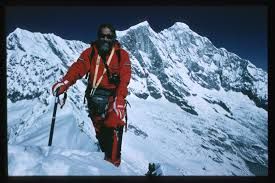

Britain’s most accomplished and probably best known mountaineer is in Jersey next week to give the last in a year-long series of lectures that have captivated audiences the length and breadth of the British Isles.
In “My Life and Times” (Jersey Opera House, Friday 28th October) 82-year-old Sir Chris Bonington says using photos and video he’ll be taking the audience on a whirlwind 90-minute adventure during which he’ll be reflecting on almost seven decades of climbing.
Bonington took up the sport when he was 16 and by his own admission was soon hooked. In the years that followed, his passion – he says “obsession” – took him around the world.
He’s been on nineteen expeditions to the Himalayas – including four to Mount Everest – back in 1985 aged 50 he was – for a while – the oldest man to have reached the summit. He was also the first Brit to climb the North Face of Switzerland’s infamous Eiger, and to climb Antarctica’s highest peak Mount Vinson.
Closer to home television audiences were glued to their screens back in 1966 when the BBC filmed his first ascent of the Old Man of Hoy – a 449-foot (137m) sea stack or tower – off the Orkneys on Scotland’s north coast. He repeated the feat again a few years ago to mark his 80th birthday and to raise funds for research into Motor Neurone Disease which had led to his first wife’s death.
Speaking from his home in Cumbria ahead of his visit to Jersey, Sir Chris says although the sport has quite literally brought him many “highs” and honours, it’s also brought many tragedies: particularly the death of many close friends. He also touches on these in his presentation.
On his 1970 Annapurna expedition (an 8,000m peak in the Himalayas) Ian Clough – his climbing partner on the Eiger – was killed by a falling serac (ice-pillar) on the mountain’s lower slopes. In 1975 – in the first successful British ascent of Everest – an expedition led by Bonington - cameraman Mick Burke was in the second wave of climbers attempting to make it to the top when a two day storm set in and he presumably froze to death. Again on Everest, this time in 1982, two members of the expedition – Pete Boardman and Joe Tasker perished. And in 2004, Arne Naess, the leader of the first successful Norwegian ascent of Everest, and the one in which Bonington, finally made it to the top, was killed in South Africa, when his anchoring equipment failed, and he fell 103m.
Rather philosophically Sir Chris notes “it’s pure total luck that I have survived. I am a careless climber and I can think of at least ten times when I shouldn’t have got away with it. When you’re climbing at the very limits of what’s thought possible, you really are exposing yourself to danger. The odds are against you. One mistake and it can all be over. Statistically I probably shouldn’t still be here.” But, he is, and the conversation moves on to what’s left to do in mountaineering.
Personally he says organising expeditions has brought him as much enjoyment and satisfaction as being a climbing member and making it to the summit: “They’re two sides of the same coin”. There are no regrets not having made it to the summit of K2 – often called the “mountaineer’s mountain” – the second highest peak in the world, technically more challenging than Everest and with a far higher fatality rate. Bonington’s K2 1976 Expedition was aborted very early on after Nick Estcourt was killed in an avalanche.
For someone who’s achieved so much, and seen so many changes in the sport, Bonington isn’t one of those who’s happy to live in the past.
When he started out the big mountains were still mostly climbed by what’s rather pejoratively called “siege tactics”: establishing a series of camps up the mountain and making repeated trips up and down between them stocking them with supplies until the team was in a position to “push” for the summit. He saw a shift – and in some ways led a transition – towards light-weight “Alpine ascents, in which a small team slowly progresses up the mountain carrying all their gear with them. Others have taken things even further shunning the use of bottled oxygen, climbing solo, climbing without ropes, climbing out of season, and taking on ever more challenging routes or attempting to climb existing routes in record-breaking times. Bonington welcomes it. “This is what endeavour is all about. Finding new challenges. Continually pushing yourself, and the boundaries”.
If he were younger he says he would like to be one of the growing number of climbers who on reaching the summit paraglide, parasail, base jump or launch themselves off the top wearing “wingsuits”. Here he highlights a growing band of new British climbers/adventures led by Leo Holding and Alex Lee.
In the absence of being able to follow in their slipstream, Bonington has returned to an earlier wave of adventurers, amongst them Bill Tillman, who combined sailing and mountaineering. Bonington recently teamed up with Sir Robin Knox-Johnston – the first person to sail non-stop around the world, and founder of Clipper races – a round-the-world sailing race for novices which Jersey won in 2002 – and together they went sailing and climbing off Scotland and Greenland.
Sir Chris’s “Life and Times” certainly have been action-packed, and his lecture – whether you’re an active climber, an armchair one, or simply just interested in hearing a riveting speaker – sounds like it’ll have you captivated.
Comments
Comments on this story express the views of the commentator only, not Bailiwick Publishing. We are unable to guarantee the accuracy of any of those comments.